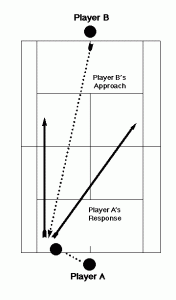
Passing Shot Drill
(diagram below)
During the Boys 16’s and & 18’s nationals at Kalamazoo back in the early 90’s, a well-known coach asked one of the match charting companies attending the tournament to monitor a particular statistic.
The coach was interested in seeing how successful players were when they tried to pass an approaching opponent off the opponent’s approach shot, and how successful they were when they waited to pass on the second ball.
The resulting statistics showed that when a player at the baseline tried to pass an opponent off the approach shot, he won the point 27 percent of the time. When the baseline player waited to pass on the second ball, he was successful 65 percent of the time.
Why was this?
When players try to immediately pass an approaching player, they are generally trying to hit a winner from a defensive position, usually having to play a deep, low ball. In addition to the geometric difficulties of this shot, players are also more likely to be defensive mentally, tensing their muscles, gripping the handle tightly and causing a deceleration in their swing.
Approaching players are able to much more effectively close the net and attack a ball that is rising because it was hit late or from deep in the court.
When baseline players took the approach shot and played it to one the side of the court and shorter (at least in front of the service line), this made the approaching player move to one side of the court to play the ball, usually volleying a low ball back up, rather than putting a high ball away.
While the approaching player was almost always able to get the first ball back in play, he was now in a defensive position to play the next ball, caught on one side of the court and able to play only a neutral or defensive volley.
The baseline player could now hit behind the net player if he tried to recover to the center of the court, to the open court if the player stayed and defended the line, or lob over the player who was moving laterally in either direction.
To raise the level of success of your players against serve and volleyers and all-court players, drill your players to improve their ability to change depth and direction against attacking opponents.
Second-Ball Passing Drill
Step #1 — Have two players (A & B) begin a rally from the baseline.
Step #2 — After two or three strokes, Player A (the one working on his passing skills) hits a short ball (any ball off which his opponent can approach) to Player B.
Step #3 — Player B approaches (most often down the line with a slice), restraining from hitting a winner so that Player A can work on his passing skills.
Step #4 — Player A must return the approach shot to one side of the court with a trajectory that will make it land before it crosses the service line.
Step #5 – -Players A and B play out the point.
Keep score, switching roles after each game.
In order to work on Player A’s ability to hit the ball in front of the service line effectively, Player A automatically loses the point if his or her first ball goes beyond the service line, even if it is a clean winner. This means no lobs. Player B may let first balls go he or she feels will land on or behind the service line.
Player A should develop the ability to drop balls in front of approaching players, rather than trying to hit winners. Player A should also develop the skill to determine how to win the point off the second ball, based on the positioning of both players after Player B’s first volley.






